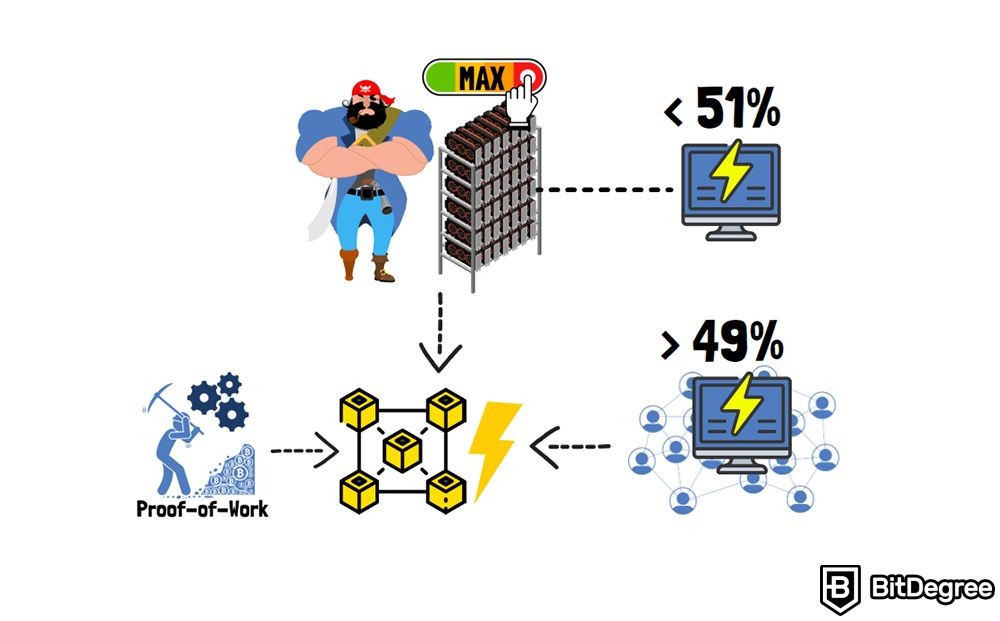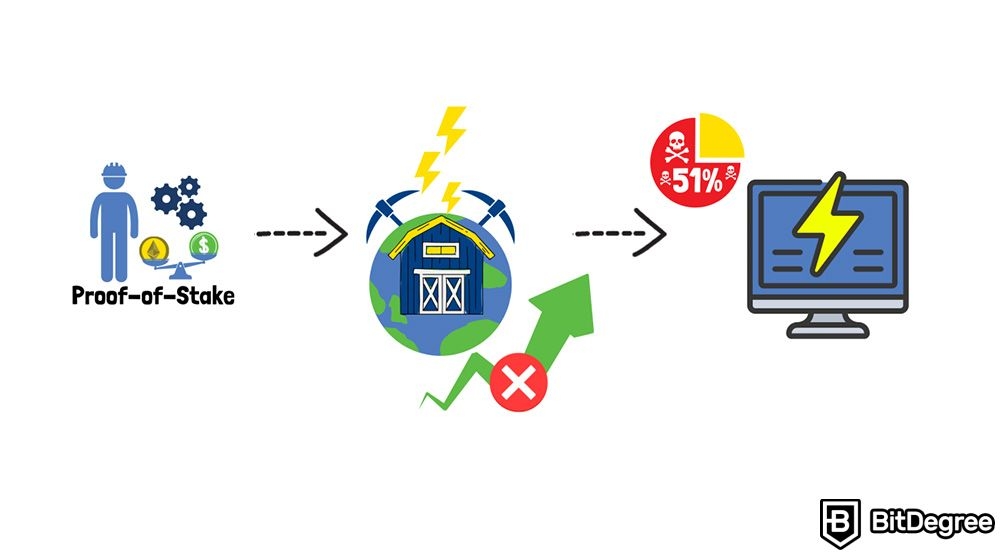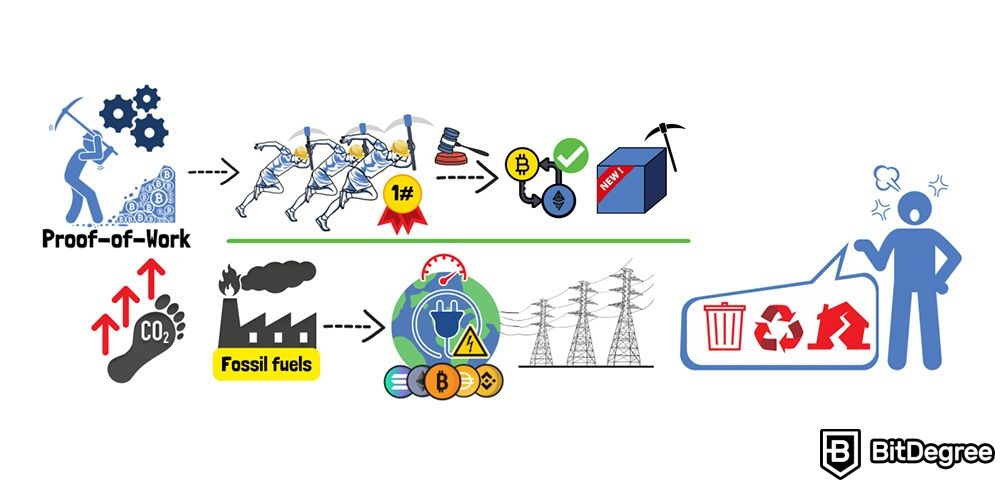9.4 Proof-of-Work VS Proof-of-Stake: The Differences That Matter
Stop overpaying - start transferring money with Ogvio. Sign up, invite friends & grab Rewards now! 🎁
In this section, we’re going to address what is the “Proof-of-Stake vs Proof-of-Work” debate all about.
When it comes to the matters of a blockchain, “Proof-of-Work vs Proof-of-Stake” is a question you simply cannot avoid. In the previous sections, I’ve covered the definitions of both of these mechanisms, but this subject requires a bit more looking-into.
There’s a reason why this debate is such a fierce one. And it can get really intense, since, as you’re about to see, both sides have strong arguments and advantages that cannot be reconciled. I’ll explain them to you in this section, and you’ll see how tough it can get when it comes to choosing a side!
So, in this section, I’m going to dissect the question of “what is Proof-of-Stake vs Proof-of-Work.” You’ll be able to understand what changed when it comes to mining Ethereum in “Proof-of-Work vs Proof-of-Stake,” what is the difference between the two mechanisms, and everything in between.
Let’s get to it!

Video Explainer
Video Explainer: Proof-of-Work VS Proof-of-Stake: The Differences That Matter
Reading is not your thing? Watch the "Proof-of-Work VS Proof-of-Stake: The Differences That Matter" video explainer
Proof of Work vs Proof of Stake: Which is Better? (ANIMATED)


Definitions
In order to begin understanding what is “Proof-of-Stake vs Proof-of-Work” , we need to take a step back, and understand this: both Proof-of-Stake and Proof-of-Work are consensus mechanisms. So, what’s that?
A consensus mechanism is like a rulebook that describes the way a blockchain is supposed to work. It maps out the right way to validate transactions, and in what order they should be added to the blockchain. By doing so, it ensures that every network participant receives the same information; therefore, no malicious actions, tampering, or cheating could take place.

You can see it as the road traffic rules. Every driver, agrees upon the rules and knows what to expect when driving down the road. To continue with the comparison, you could say that the UK, for example, runs on a different “consensus mechanism,” when it comes to the traffic. The British all drive on the left, yet an organized system still prevails. That’s all thanks to the “consensus mechanism”!
Adhering to a shared set of rules is important because it keeps the blockchain’s integrity, and makes it secure. All of this is achieved without the need for a central authority, all thanks to a consensus mechanism.
Different blockchains have different cryptocurrencies. And the set of rules that these blockchains follow are, in many cases, different. Proof-of-Work and Proof-of-Stake are two different sets of rules, since they both are different consensus mechanisms. There are many others, but these two are the most prominent ones, since two of the most well-known and widely-used cryptocurrencies, Bitcoin, and Ethereum, run on them.
Core Principles
Okay, that was the fundamental theory when it comes to consensus mechanisms, blockchain, “Proof-of-Work vs Proof-of-Stake” debate, and everything in between. Now, it’s time to address their core principles. By doing so, we’re gonna see their main differences, as well.
Let’s begin with Proof-of-Work, or, as it’s commonly known, PoW.

PoW is almost synonymous with “computational power,” since it entirely relies on it. PoW participants, also known as miners, use their own resources, such as computational power, and energy, in order to contribute to the network’s security and functionality.
By investing into special devices and mining machinery, miners get to participate in validating transactions, and creating new blocks. The blockchain is literally created out of the computational power that these miners provide it with. That’s why such Bitcoin ambassadors, like Michael Saylor, like to call this coin “Digital Energy,” since it’s literally electricity transformed into a digital currency.
Therefore, miners compete against each other by investing into more powerful mining rigs, so they could end up producing more computational power, and thus, increasing their chances of being the ones who’ll get the opportunity to validate transactions, and continue building the blockchain.
If they succeed, they get incentivized by receiving rewards. These rewards come in cryptocurrency that’s native to the chain that these miners are contributing to.
You could think of mining as a very complex online multiplayer game. Every miner, in this case - gamer, connects to the server to compete in an intense everyone vs everyone game. Last man standing wins, and, thus, earns the reward. But, all of the other gamers had to invest their time, energy, and computational power to participate in the game, nevertheless!
Quite naturally, miners want to succeed and receive the reward, since it’s the only way of making returns on their investments. And, as it’s designed in PoW’s architecture, the participants with the most computational power stand the most chances to “win” the race of getting to validate the new block.
Therefore, you could conclude that one of PoW’s core principles is competition. It’s just a single word, yet it helps so much when it comes to understanding the “what is Proof-of-Stake vs Proof-of-Work” question.
Now, Proof-of-Stake, or PoS, in short, solely relies on staking, thus the word “stake” in “Proof-of-Stake.”

Staking is a process of locking up a certain amount of your own cryptocurrency in the blockchain. This works as collateral that keeps the stakers accountable, and incentivizes them to do their job properly. This “job” is the same as that of miners on a PoW network - to validate new transaction data, to add it to existing blocks, and, when they get full, to create new blocks.
So, in PoS, stakers are the ones that make sure the blockchain keeps its integrity, is secure, and functional.
PoS does not rely on computational power as much as PoW does. In this consensus mechanism, it’s not computational power that decides who’s gonna be one to validate transactions, and create new blocks, but it’s the number of coins that stakers have staked on the network.
Let’s illustrate it with a simple example. If you want to win the jack pot, you have to buy yourself a lottery ticket. The more tickets you buy - the more chances you have of becoming the lucky one. So, the more you stake, the more chances you have of becoming the “lucky one” to get the chance to validate transactions and receive rewards.
And, just like with PoW, in case of successfully validating a transaction, validators receive rewards. In case they try to act maliciously, they’d risk losing their staked assets. Therefore, all of the network’s participants feel safe, since such acts are punished. It’s an effective way of repelling actors with potentially malicious intentions.
If PoW encourages competition among its validators, PoS goes the opposite way. It doesn’t rely on sheer computational power, but more on chance. And by “chance”, I mean the fact that PoS validators, in most cases, get selected through a randomized process. The system randomly chooses “the winner” among the stakers.
But, the higher the staked amount, the higher the chances of being chosen. Yet, no matter how much computational power these validators may own and be able to produce, this will not increase their chances of getting to validate the transaction, and, thus, receive the reward.
So, instead of competition, PoS applies the “lottery” method.
Security
To continue solving the “what is Proof-of-Stake vs Proof-of-Work” puzzle, the question of security must be addressed. Both of the consensus mechanisms have their advantages and disadvantages when it comes to this question.
In order to properly understand it, it’s important to understand a concept of what’s known as a “51% attack.”
In PoW, the network is powered by the computational power that comes from all the network participants. But, what if someone set up a mining rig so powerful that it could provide more than half of the entire network’s computational power?
This would mean that they could, hypothetically, take over the control of the block creation, and, essentially, choose what data to validate. To put it shortly, this would allow this actor to manipulate the blockchain.
So, a 51% attack (also known as a majority attack) is a scenario in which a single entity or a group of malicious actors gains control of more than 50% of the total computational power. This would allow such an “attacker” to manipulate transactions, reverse them, and, essentially, mess everything up.
So, how susceptible is PoW to such an attack?

It depends on the size of the network. For example, the most important PoW blockchain is the Bitcoin network. And, in order to execute a successful 51% attack on the Bitcoin network would be… Very expensive.
In order to set up a mining rig that could overtake the network, would require an astronomical amount of computational resources, specialized hardware, and electricity. The cost of conducting such an operation is so high, that it simply makes it not worth it, since the possibility of failure is always there.
This would mean that the attacker would have invested all that money into setting up the required gear, and simply not achieving the goal. Therefore, the size of a network works as a deterrent.
Now, what about PoS?
When it comes to Proof-of-Stake, owning the largest crypto mining farm in the world would not increase anyone’s chances of obtaining the majority of the network’s computational power. The danger comes in a different shape.

In this consensus mechanism, an attacker would have to become the largest staker in the entire network. And by largest, I mean that the attacker would have to acquire more than 50% of the total amount of cryptocurrency that’s staked on the blockchain. They would have to stake more than the rest of the stakers combined.
But, there are mechanisms put in place to mitigate the risk of it.
First of all, it would be costly. The more stakers there are, the costlier it becomes for a hypothetical attacker to accumulate more than 50% of the entirety of the staked coins.
Then, if, in a hypothetical scenario, an attacker manages to obtain that many coins, they would still face the risk of failure. In such a case, the PoS malicious activity deterrents would get activated and confiscate all of the coins from the attacker.
And finally, if the attacker, nevertheless, would manage to pull the attack off, the news about such an event would destroy the cryptocurrency’s image, and people would start selling it, thus, reducing its value. The attacker would end up with way less in their hands, than they had to invest, in order to succeed on a mission like this.
So, to sum this chapter up, while both PoW and PoS networks are theoretically vulnerable to 51% attacks, the chances of them actually taking place are low. It depends on the size of the network, so, if we’re talking about the main cryptocurrencies, the chances of witnessing a 51% attack are very low.
Criticism
Finally, it’s time to address what are the main points of criticism of both of these consensus mechanisms. Let’s take a look at PoW first.
As I’ve mentioned above, Proof-of-Work is fueled by competition. And this competition leads to some objective problems that are concerning not only to the crypto industry, but also to the rest of the world.
Since PoW requires miners to compete over who’s gonna be the first one to get the right to validate transactions and create new blocks, this results in a colossal increase in global energy consumption levels. The electricity that it consumes is often produced by burning fossil fuels. Which, of course, increases the carbon footprint that the crypto industry leaves on the planet. Critics emphasize this as something wasteful, unsustainable, and damaging.

In the context of climate change, one should not be surprised that both local and global authorities are about to get more and more strict about such matters. Therefore, PoW blockchains may face regulatory issues in the long turn. This would be detrimental to cryptocurrencies that depend on this mechanism.
Proof-of-Stake manages to avoid this PR crisis, when it comes to environmental impact, since the amount of energy that it requires is almost incomparably smaller. Yet, PoS is under fire for another reason. Critics argue that PoS is way more susceptible to the problem of centralization than PoW is.
There are more ways for network participants to obtain a significant amount of coins in PoS than it is in PoW. For example, upon the launch of a blockchain, the Initial Coin Distribution takes place, and blockchain contributors, supporters and investors receive their promised shares of the coins.
This automatically increases their influence on the blockchain, and puts them in an unbalanced relationship with the other network participants. Thus, such actors could continue accumulating their crypto wealth, which would furtherly lead to the centralization of power in the hands of a few network participants.
These participants aren’t always individuals. Sometimes, they can be corporations, crypto exchanges, and so on. Thus, the momentum of furtherly increasing their wealth, and, therefore, their influence over the blockchain, always remains high.
This is why critics argue that PoS is way more prone to ignoring the tenets of decentralization and treating all network participants in an unfair manner, which contradicts the initial idea of a Peer-to-Peer network system.
Wrapping Up
As you can see, the question of “what is Proof of Stake vs Proof of Work” debate is very real. It encapsulates two very different approaches to how the optimal blockchain is supposed to work. And this debate is not going to end anytime soon. The opposing sides differ in regards to their goals, values, and the overall vision of the perfect blockchain project.
Of course, there are more consensus mechanisms out there, and it’s safe to say that many more will be introduced eventually. Special problems require special solutions. But sometimes, these solutions create new, not-seen-before problems. Therefore, we can summarize that the great debate of which consensus mechanism is the best, is far from over.










